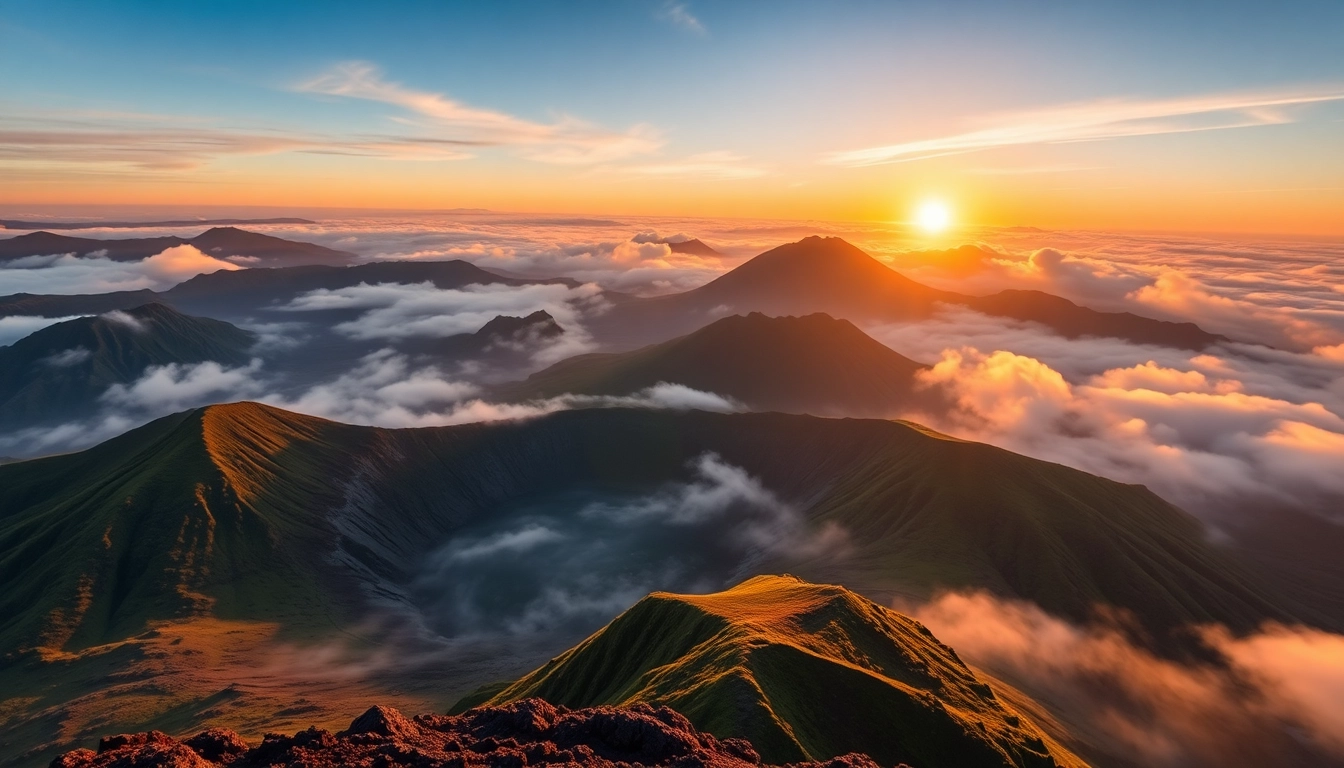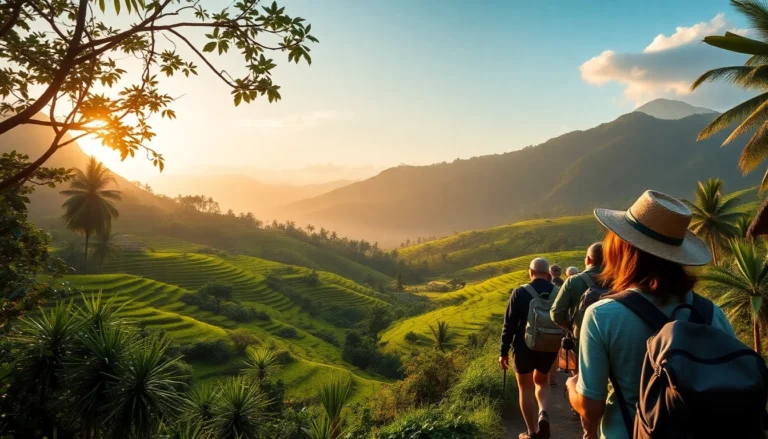Introduction to Mount Rinjani and Its Significance
Perched majestically on the island of Lombok, Indonesia, Mount Rinjani stands as a symbol of natural beauty, geological intrigue, and cultural heritage. As the second highest volcano in Indonesia, its towering presence not only defines the landscape but also embodies centuries of history, spiritual meaning, and environmental significance. This active stratovolcano, with its complex volcanic system, draws thousands of adventurers, nature enthusiasts, and cultural explorers each year, eager to experience its breathtaking vistas and discover its hidden secrets. Understanding Mount Rinjani’s multifaceted importance begins with a look at its geographical positioning, historical activity, and the profound role it plays in local culture and spirituality.
Geographical Location and Physical Features
Mount Rinjani is situated in the northern part of Lombok, within the Gunung Rinjani National Park, which spans over 41,330 hectares of diverse ecosystems. The volcano’s summit reaches an elevation of approximately 3,726 meters (12,224 feet) above sea level, making it the second highest volcano in Indonesia, surpassed only by Mount Kerinci. Its formidable cone is surrounded by a caldera measuring roughly 8 by 13 kilometers, housing a stunning crater lake called Segara Anak, which translates to “Child of the Sea.” This lake, with its vibrant blue hue, is a mesmerizing feature and a popular trekker destination. The diverse geographical features of Mount Rinjani include lush forests, steep ridges, hot springs, waterfalls, and the volcanic terrain that has been shaped by millennia of eruptions.
The volcano’s geological activity is a result of the complex tectonic interactions within the Indo-Australian Plate subducting beneath the Eurasian Plate. This dynamic process continually fuels volcanic activity, which has shaped the island’s landscape and created fertile volcanic soils vital for local agriculture.
Historical Eruptions and Volcanic Activity
Mount Rinjani’s eruptive history is vast and layered, offering a vivid record of its volcanic dynamism. The earliest known eruption dates back to ancient times, with geological evidence suggesting significant activity over the past few thousand years. Notably, the 1257 eruption of Mount Samalas, which is now understood to be part of the Rinjani volcanic complex, was one of the most catastrophic in Indonesian history. This eruption ejected an enormous volume of ash and pumice, leading to global climatic impacts like a drop in temperatures and failed harvests across the world. The volcanic system’s activity has softened in recent centuries but remains vigilant with regular monitoring for signs of renewed eruptions.
In 2016, Mount Rinjani experienced heightened volcanic activity, leading to ash plumes and the temporary closure of the national park. Authorities closely monitor seismic activity, gas emissions, and ground deformation to assess potential eruption threats, aiming to ensure the safety of residents and visitors. The volcano’s active status adds a layer of intrigue for researchers and travelers alike, as each new eruption provides insights into the Earth’s geological processes.
Cultural and Spiritual Importance in Lombok
Beyond its physical grandeur, Mount Rinjani holds profound spiritual and cultural significance for the local Sasak and Balinese communities. It is considered sacred, embodying ancestral spirits and deities that maintain the balance of nature and human life. Many local legends and traditional beliefs associate the mountain with divine presence, and annual ritual ceremonies often take place at its base or on its slopes.
Specifically, the indigenous Sasak people view Rinjani as a guardian mountain, a place where offerings are made to appease the spirits and ensure agricultural fertility. The annual Rinjani Festival, involving rituals, dance, and prayer, exemplifies the deep-rooted spiritual connection and respect for the mountain. Additionally, the volcanic crater lake Segara Anak is believed to possess healing powers, and some pilgrims undertake spiritual journeys to this area seeking blessings and guidance.
Planning Your Trekking Adventure on Mount Rinjani
Best Time to Visit and Seasonal Considerations
Timing your visit to Mount Rinjani is crucial to ensure a safe, enjoyable, and successful trek. The most favorable seasons are during the dry months from April to October, when the weather is typically clear, and rainfall is minimal. June through September often offers the best conditions for trekking, with stable weather, reduced cloud cover, and lower humidity. Visiting during the rainy season (November to March) poses risks such as slippery trails, increased landslide potential, and low visibility.
It is important to consider local climatic patterns and the peak trekking seasons, which coincide with dry periods and school holidays to accommodate international tourists. Planning ahead and booking guided tours in advance during these busy months is highly recommended.
Required Equipment and Preparations
Embarking on a Rinjani trek demands meticulous preparation and proper gear to handle challenging terrain and variable weather. Essential equipment includes:
- Sturdy hiking boots with ankle support
- Layered clothing (thermal wear, waterproof jackets, windproof layers)
- Headlamp and extra batteries
- Sleeping bag suitable for cold temperatures
- Sun protection (sunscreen, sunglasses)
- High-energy snacks and hydration supplies
- Personal first aid kit
- Trekking poles for stability on steep slopes
- Camera or smartphone for capturing scenic views
Preparation also involves physical conditioning—strengthening legs, cardiovascular endurance, and acclimatization to high altitudes. Hydration, nutrition, and ample rest before the trek are vital for stamina and health.
Guided Tours and Trekking Routes
Most trekkers opt for guided tours offered by reputable operators, ensuring safety, logistical support, and local expertise. Guided routes typically span 2 to 4 days, with options tailored to experience levels. Common trekking routes include:
- Sembalun Route: Known for its gradual ascent and scenic panoramic views, starting from the village of Sembalun Lawang.
- Torean Route: Starting from Senaru, this route offers lush forests and sulfur hot springs along the way.
- Summit and Crater Trek: Reaching the summit at 3,726 meters, then descending into the crater lake and exploring surrounding geothermal features.
Each route varies in length and difficulty, and choosing the right path depends on fitness, experience, and interests. Guided tours often include permits, porters, camping equipment, and safety protocols, essential for a successful expedition.
Highlights and Attractions of Mount Rinjani
Crater Lake and Hot Springs
The jewel of Mount Rinjani is the stunning Segara Anak crater lake. Its vibrant blue waters are nestled within the volcanic caldera, offering picturesque vistas and a serene ambiance. Visitors often take boat rides across the lake or relax in nearby hot springs, which are heated by geothermal activity beneath the volcano. These natural hot springs provide soothing baths after strenuous hiking, and are considered to have therapeutic properties, attracting both trekkers and locals.
Rinjani National Park Ecosystem
Within the national park, a rich ecosystem flourishes, featuring diverse flora and fauna endemic to the Wallacea transition zone. The park hosts a variety of orchids, bird species, mammals, and reptiles. Notable wildlife includes the black ebony leaf monkey, eagles, and some rare orchid varieties. Environmental conservation efforts focus on maintaining biodiversity and protecting vulnerable species from habitat degradation caused by tourism and climate change.
Scenic Views and Photogenic Spots
The ascent of Mount Rinjani offers countless scenic vistas, from lush rainforest canopies at lower elevations to volcanic terrains and surreal crater landscapes. Sunrise from the summit provides panoramic views of the surrounding islands and the vast ocean beyond. Other photogenic spots include the hot springs, waterfalls, and the cliffs overlooking the crater lake. These stunning landscapes make Rinjani a favorite among landscape photographers and adventure lovers alike.
Safety Tips and Common Challenges
Altitude Sickness and Physical Preparation
High-altitude trekking introduces risks such as altitude sickness, which manifests as headaches, nausea, dizziness, and fatigue. To mitigate this, pace yourself appropriately—descend or rest if symptoms develop—and ensure adequate acclimatization. Physical fitness is paramount; engaging in cardiovascular exercises, strength training, and gradual altitude exposure weeks before the trek can greatly enhance endurance. Consulting with health professionals about altitude medication is advisable for sensitive individuals.
Weather Conditions and Risk Management
Weather on Mount Rinjani can change rapidly, with thunderstorms, fog, and temperature drops common at higher elevations. Proper gear, including waterproof clothing and warm layers, is vital. Trekkers should monitor weather reports closely and avoid ascending during storms or heavy rainfall to prevent slips and landslides. Emergency communication devices, such as satellite phones, are recommended in remote areas for safety assurance.
Environmental Preservation and Responsible Tourism
As one of Indonesia’s treasured natural sites, preserving Mount Rinjani’s pristine environment is a shared responsibility. Visitors should adhere to Leave No Trace principles—pack out all waste, avoid disturbing wildlife, and stay on designated trails. Supporting local guides and businesses promotes sustainable tourism revenues that fund park conservation and community development projects. Educating oneself about local customs and environmental challenges further fosters respectful and responsible visitation.
Additional Resources and How to Book Your Trip
Official Park and Tour Operator Links
For authoritative information, the official Rinjani National Park website (https://www.rinjaninationalpark.id/) provides detailed guidelines, updates, permits, and maps. Reputable tour operators specializing in Rinjani treks offer packages that include logistics, guides, equipment, and safety support. Booking in advance, especially during peak seasons, ensures availability and peace of mind.
Travel Tips for Lombok and Surroundings
Beyond the mountain, Lombok offers a plethora of attractions: stunning beaches such as Kuta and Senggigi, waterfalls like Sendang Gile, cultural villages, and surfing hotspots. Visitors should plan their itinerary to include local cultural experiences, authentic culinary delights, and eco-tourism activities. Accessibility from Bali via ferry or flight makes Lombok an easy addition to broader Indonesia travel plans.
FAQs and Expert Advice for First-Time Trekkers
First-time trekkers often have numerous questions, such as:
- Q: How difficult is the Mount Rinjani trek?
- A: The trek varies from moderate to challenging, with steep ascents and high altitudes demanding good physical condition and preparation.
- Q: How long does the trek take?
- A: Typically 2 to 4 days, depending on the route and pace.
- Q: Do I need to camp or can I stay in lodges?
- A: Options include camping with supplied gear or staying in local lodges and guesthouses at base camps.
- Q: What are the health considerations?
- A: Acclimatization to altitude, hydration, and physical readiness are key. Consult health professionals if necessary.
Engaging with experienced guides, thorough planning, and maintaining respect for local customs will culminate in a memorable and successful Mount Rinjani experience.




